
Spring 2019
®
SAN VICENTE TREES
This is from Lake San Vicente in San Diego, Calif. The purpose of this image is primarily to show you the value of using DownScan imaging, and how it can teach you to interpret traditional sonar.
The upper right panel is traditional 2D sonar, and you can see that I selected 83kHz for the frequency.
Many anglers looking at this image might assume it was displaying a big school of shad (blue with red in center) with bass shown by red arches toward the base. However, compare this to the same image in the lower right panel using DownScan.
The much higher freqency in the DownScan image (455 kHz) provides greater definition and target separation, in which you can clearly see the blob is not shad, but instead 45-foot tall trees. You can also see the rocky bottom at 65- to 70-feet deep. The regular sonar shows the hard bottom as yellow, and the DownScan image draws you a picture of the rocks.
Tip: set-up your fishfinder to display DownScan images directly below or above your traditional 2D sonar image, and you will learn what traditional sonar is showing you by comparing the two images as they are being drawn on your screen. With experience you will be able to tell each blob is actually showing you unique information.
page 66
STEEL FRAME 10’
Screenshot #4 is also of Lake Washington, in the area where a large lumber mill used to exist.
I found this amazing structure years ago and I regularly catch nice smallmouth bass from it in the fall and winter months. I suspect it is the scaffolding of an old boat drydock that sunk in one of the many storms that pound the lake.
This screenshot was also taken with the original Lowrance StructureScan transducer, the LSS-1 using 800 kHz.
The upper right panel is the DownScan image which is zoomed-in (three times) to provide greater detail of the 25- to 40-foot zone at the bottom.
As you can see by the water temperature displayed on this panel (45.6 degrees), I was fishing here in the winter.
The bottom right panel is the traditional sonar image (200 kHz), and is not zoomed in. As you can tell, there is something on the bottom, but there is no way to imagine it is scaffolding without the DownScan image above, or by looking at the SideScan image in the upper right panel. You will also see several logs (black lines) laying on the bottom on the left side of the SideScan panel (upper left).
Hope this helps to clear up some of the interpretation mysteries of fishfinders. To date most of the images we have looked at are from legacy Lowrance HDS units (Gens 1-3). Stay tuned for future Lowrance image interpretation articles using both the HDS Carbon and new HDSLIVE units. •